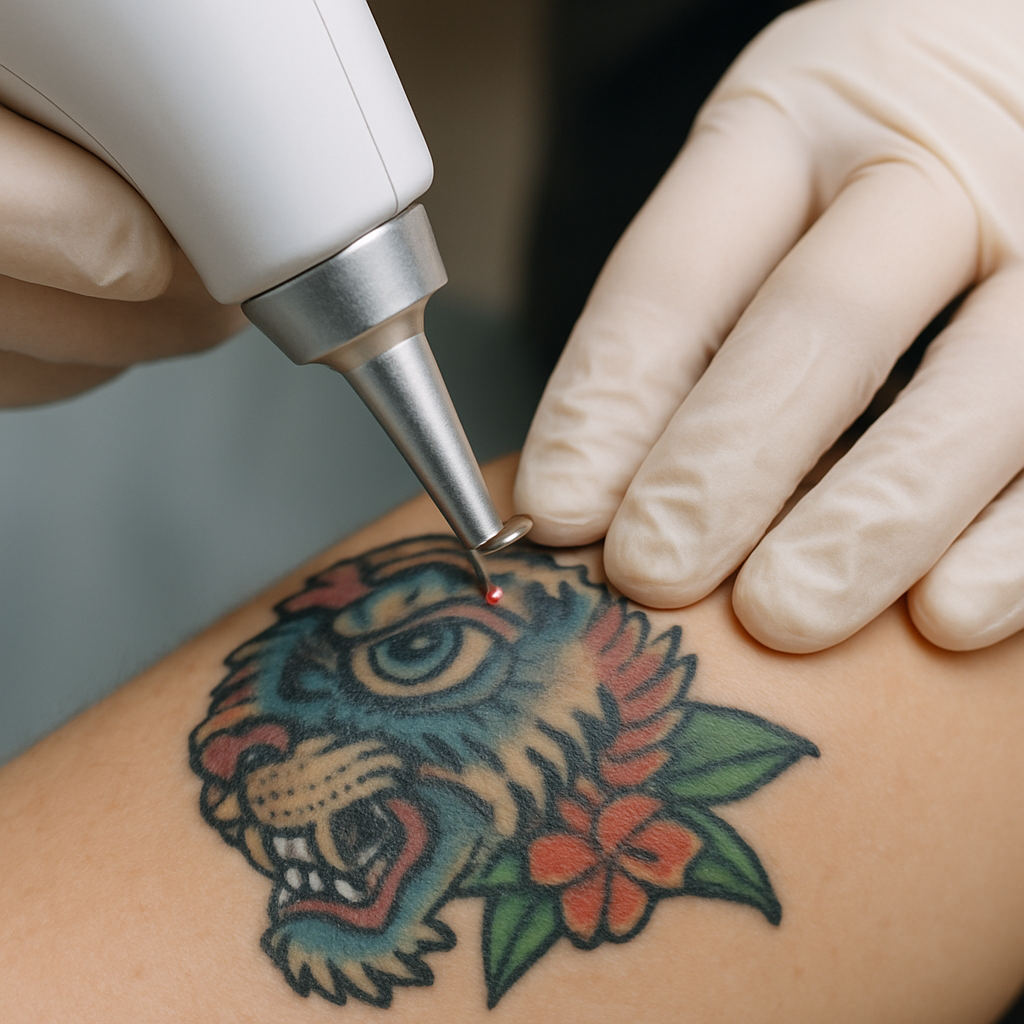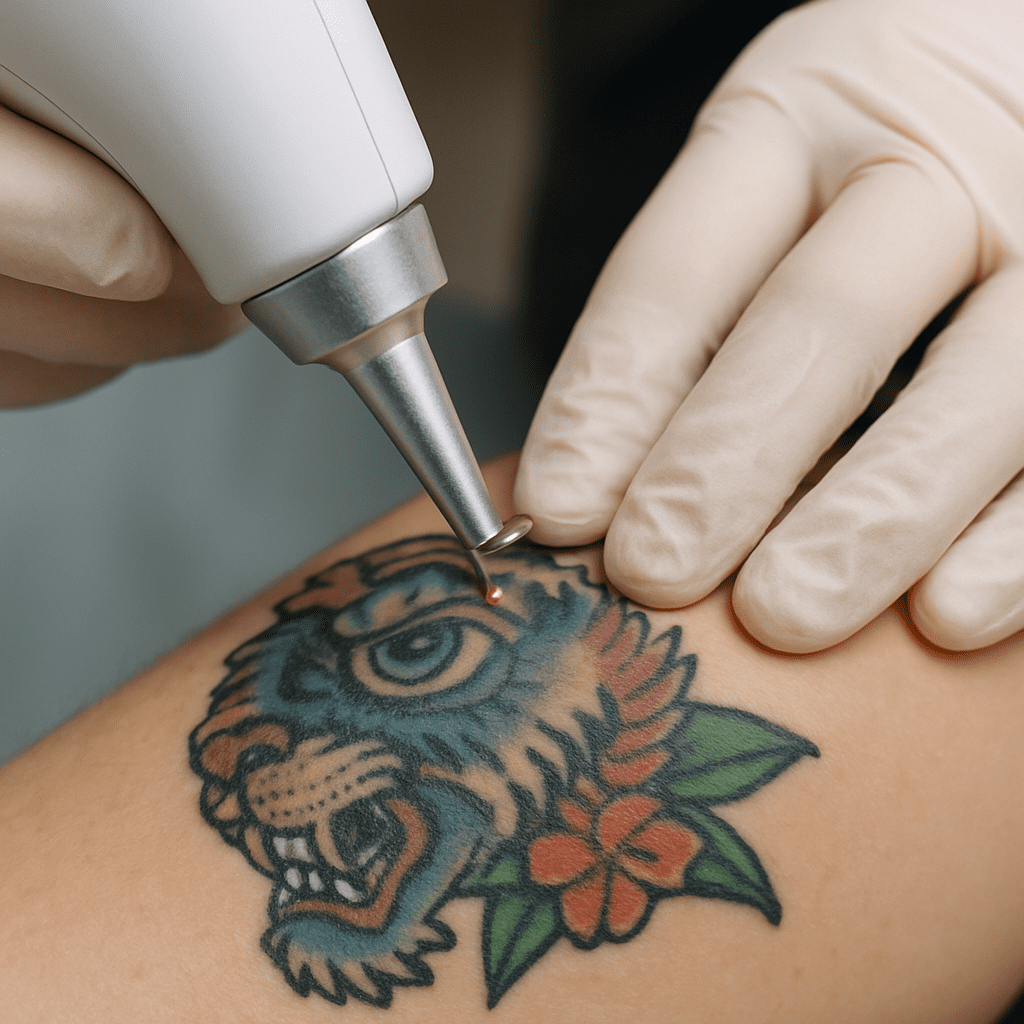Ever stared at an old tattoo and felt that familiar mix of regret and hope? Like, ‘What if I could just erase this chapter and start fresh?’ You’re not alone. Lots of people consider laser tattoo removal, but then they hit that wall—wondering about the cost. It’s frustrating, right? Not knowing what to expect can make the whole idea feel out of reach.
Here’s the thing: understanding laser tattoo removal cost isn’t just about dollars and cents. It’s about feeling confident to take the next step without surprises. When you get clear on the price, you’re not left guessing or stressed when the bill rolls in.
But why is the cost such a tricky question? Because it depends on a bunch of things—the size and color of your tattoo, where it’s located, how many sessions you’ll need, and even the technology used. It’s kind of like buying a car—you wouldn’t pick one without knowing the features and price, right?
Imagine this: you walk into a clinic feeling anxious, unsure if you can afford what it really takes to say goodbye to that tattoo. Just thinking about hidden fees or extended treatments makes your head spin. What if you could get a clear breakdown upfront? Wouldn’t that make the whole process less stressful and more empowering?
That’s why diving into the details of laser tattoo removal cost matters. It helps you plan financially and emotionally, so you don’t feel stuck halfway through your journey. Plus, it opens up realistic expectations about results and timing.
If you want to get a better handle on these costs and what goes into them, we’ve got you covered. And while you’re here, you might find it helpful to browse through insights on managing discomfort during laser tattoo removal—gotta know what the experience feels like too, right?
Ready to break down the mystery and finally take control? Let’s dive in and unpack everything about laser tattoo removal cost, so you can make the smartest choice for you.
TL;DR: Key Insights on Laser Tattoo Removal Cost
Wondering about laser tattoo removal cost? It really comes down to your tattoo’s size, color, and how many sessions you’ll need—none of which is one-size-fits-all.
Plus, technology and clinic location matter too, affecting price and results. Knowing this upfront can save you surprises and keep your journey on track.
Factors That Affect Laser Tattoo Removal Cost
Let’s be honest: figuring out what drives the cost of laser tattoo removal can feel like decoding a secret map. But once you get it, it’s actually pretty straightforward—and it can save you some serious surprises down the road.
Size Matters – More Than You Might Think
Here’s what I mean: a tiny symbol on your wrist isn’t going to cost the same as an intricate sleeve. The bigger your tattoo, the more laser time it demands. That often means more sessions and higher overall costs. Plus, bigger tattoos might take longer to fade fully—you’re paying not just for size but also for persistence.
Color Complexity Can Boost Costs
Think your tattoo’s color palette doesn’t affect price? Think again. Black ink is usually the easiest and cheapest to remove because lasers target its pigment more efficiently. But those vivid blues, reds, and greens? They often require specialized lasers or more treatments to break down properly, which bumps up the cost. It’s kind of like the difference between cleaning black coffee off a shirt versus a multicolor ink spill.
By the way, Express Med Spa explains this nicely, noting that complex colors might need different laser types or more sessions. So yeah, your tattoo’s hue really matters.
Your Skin Type Isn’t Just Skin Deep
The way your skin reacts makes a difference, too. Darker skin tones can be a bit trickier to treat safely. Laser settings need to be gentler to avoid pigment changes, which often means more sessions and, you guessed it, potentially higher costs. It’s not about fairness; it’s about getting the job done carefully so you don’t end up with unwanted skin changes.
Age and Condition of the Tattoo
Older tattoos usually respond faster to removal. That’s because the ink has had time to break down a bit. Newer or heavily saturated tattoos might cling on tighter, stretching out the number of sessions you’ll need. Think of it like weathering on a car’s paint—it’s easier to remove faded spots than a fresh, flawless coat.
Technology and Expertise—Don’t Skimp Here
Not all lasers are created equal. Clinics using modern, FDA-cleared lasers tend to give better results, often requiring fewer sessions overall. Outdated equipment? It might seem cheaper upfront, but you might be paying more in the long haul.
How about the person wielding the machine? Your provider’s training and experience matter big time. A skilled specialist customizes treatment to your specific ink, skin, and body response, which can improve results and save money over time.
Simcoe cosmetic clinic emphasizes quality and personalized care for this very reason—when you invest in expertise and technology, it pays off.
Number of Sessions and Recovery Time
Laser tattoo removal isn’t a one-and-done deal. On average, it takes several sessions spaced a few weeks apart. The number varies depending on those factors we talked about—size, color, skin type, and tattoo condition.
Each session adds cost, obviously, but rushing the process by shortening time between sessions can backfire. Your body needs time to clear ink particles safely.
Location and Pricing Models
Where you get your removal done can change the sticker price, too. Clinics in bigger cities or popular areas might charge more due to demand and overhead. But many places, including Simcoe cosmetic clinic, offer package deals or payment plans, which can make this investment more manageable.
Keep in mind, insurance rarely covers tattoo removal since it’s cosmetic. But booking a consultation can help you get a clear, personalized quote without any pressure, like what’s offered at trusted places near you (Erase and Embrace shares a transparent pricing approach that’s worth checking out).
So what should you take away from all this? Laser tattoo removal cost isn’t a fixed number because your tattoo—and you—are unique. Size, color, skin, technology, and the clinic’s expertise all play a role.
Here’s a quick checklist for when you’re shopping around:
- How big is your tattoo? (Measure it honestly.)
- What colors are involved? (Dark inks are easier to remove.)
- What’s your skin type and tone? (Make sure the clinic knows.)
- Does the clinic use up-to-date laser tech?
- What’s the provider’s experience level?
- Are payment plans or session packages available?
Answering these will give you a much clearer picture—and less room for sticker shock.
Ready to make a plan that fits your tattoo removal goals and your wallet? Start with a free consultation—you’ll get an honest, no-pressure breakdown of what laser tattoo removal cost looks like for your unique situation.

Popular Laser Technologies and Their Price Differences
So, you’re ready to dive deeper into laser tattoo removal cost, huh? One big thing to get is that not all lasers are made equal. The type of laser tech your clinic uses can make a noticeable difference in your results—and your wallet.
Let’s break it down, so you get what you’re actually paying for.
Q-Switched Lasers: The Tried-and-True Workhorse
Q-Switched lasers have been around for a while. They fire high-energy pulses in nanoseconds, targeting tattoo ink by heating it so it breaks apart. It’s like blasting your tattoo with a strobe light that’s fast enough to crack ink particles but slow enough that it heats surrounding skin a bit more than newer tech.
These lasers are solid for black and red inks but struggle a bit with blues and greens.
They tend to be less pricey per session—sometimes around $50 to $500 depending on where you go—but you might need more sessions overall, which adds up. Because the pulses are longer, there’s a slightly higher risk of skin irritation and longer healing times.
Picosecond Lasers: The Next-Gen Power Player
This is where things get really interesting. Picosecond lasers fire pulses 1,000 times faster than Q-Switched ones—think trillionths of a second.
What does that mean for you? Less heat damage to your skin, less discomfort, and usually faster results. They’re better at shattering smaller ink particles, which means they can tackle colorful, complex tattoos more effectively.
They’re the crème de la crème and used in clinics like Simcoe cosmetic clinic. But, all that tech doesn’t come cheap. These lasers—with multiple wavelength options to target every tattoo color—and advanced effects to protect your skin can retail for around $100,000 to $175,000 for the machines themselves.
When it comes to price per session, that premium shows. Expect picosecond sessions to cost a bit more, maybe $300 to $800 per session, depending on your tattoo size and colors. But most people find they need fewer sessions.
What Do All These Wavelengths Mean?
Here’s a little laser science cheat sheet: wavelengths are the light’s “color.” Infrared, red, green, blue—each wavelength targets different ink colors. For example, 1064 nm (infrared) works great for dark ink, while 532 nm is better for reds and oranges. Other wavelengths like 755 nm or 694 nm help tackle tricky greens and blues.
The best lasers, like the Candela PicoWay, come with multiple wavelengths so they can customize treatment based on your tattoo, skin tone, and color combos. That flexibility often means better results—faster.
Curious which laser suits you best? It comes down to your tattoo’s colors and your skin type. Your provider should guide you here—they’re the pros after all.
How About DIY Laser Tattoo Removal?
Sure, the idea of zapping your tattoo at home with a handheld laser pen might sound tempting. But here’s the reality: these devices don’t pack the power or precision of professional lasers. Spot sizes usually are tiny, pulse durations aren’t ideal, and wavelengths aren’t tailored to different ink colors. That means it could take way longer to see results — if at all — and the risk of skin damage goes way up.
So while it might save a few bucks upfront, going DIY often ends up costing more in frustration…and maybe a trip to a professional anyway.
Comparison Table: Laser Types at a Glance
| Feature | Q-Switched Lasers | Picosecond Lasers | DIY Handheld Lasers |
|---|---|---|---|
| Pulse Duration | Nanoseconds (slower) | Picoseconds (ultra-fast) | Variable, mostly slower |
| Wavelength Options | Limited (often 2 wavelengths) | Multiple (3-4 or more wavelengths) | Usually fixed, minimal |
| Effectiveness on Colors | Best for blacks and reds | Effective on a wide range of inks | Poor, usually ineffective on multi-color |
| Session Cost Range (approx.) | $50–$500 | $300–$800 | Low upfront but high risk |
| Skin Damage Risk | Moderate | Lower, less heat injury | High risk without expert control |
Does it seem overwhelming? It can be. But don’t worry—we’re here to help you make sense of these choices and find the best fit for your tattoo removal goals and budget.
If you want the latest on laser technologies or simply want to chat about what’s possible for your skin and tattoo, the best next step is always an in-person consult at a trusted clinic like Simcoe cosmetic clinic. They can tailor a plan—balancing price, technology, and your unique skin—that feels right.
For more detailed insight on laser equipment and how it works, check out this comprehensive breakdown of laser tattoo removal machines, or learn about the differences between Q-Switched and Pico lasers for pigment and tattoo removal. Getting informed pays off, especially when it comes to something that’s on you forever (or not!).
Average Costs by Region and Service Provider
Let’s be real: pricing for laser tattoo removal can feel a bit like trying to guess the weather a month from now. You hear numbers tossed around that range wildly, and it’s hard to pin down what you might actually pay where you live. But here’s the thing—where you get treated and who’s doing it really shapes your bill a lot more than you might expect.
For starters, location matters. Big cities and urban centers tend to have higher average costs, not just because rent is pricier but also due to the level of expertise and technology found there. In places like Toronto or Vancouver, you might see per-session prices between $300 to $600, while in smaller towns or less competitive markets, prices might drop closer to $200 or $350 per session. It’s not just about geography; the availability of clinics and demand affects the pricing climate too.
Now, think about the service provider side. You’ve got everything from high-end medspas to dermatologist offices and independent practitioners offering laser tattoo removal. Naturally, a full-service medspa with advanced pico lasers and a skilled team, like the Simcoe cosmetic clinic, often charges more upfront—but you’re investing in equipment and care quality that usually means fewer sessions and better results.
Contrast this with smaller providers who may use older Q-switched lasers or offer cheaper “pay as you go” treatments. While cheaper might seem like a bargain, it can sometimes lead to more sessions, prolonging your tattoo removal journey and increasing the total cost over time. It’s kind of like buying cheap shoes that wear out fast—you save a bit at checkout, but then you’re back in the store sooner.
Ever wondered how pricing models change the bottom line? Many clinics offer per-session pricing, which sounds flexible but can add up quickly as treatments often require 8 to 10 or more sessions spaced weeks apart. Others, like Simcoe cosmetic clinic, provide package deals where you pay upfront for a full removal plan—this can be a smarter financial move if you’re committed. It’s worth asking about these options because sometimes spending a bit more upfront saves you frustration and cash later.
Here’s a quick comparison to give you a clearer picture:
| Factor | Urban High-End Clinics | Smaller Town Clinics | Independent Providers / Pay per Session |
|---|---|---|---|
| Average Price per Session | $300–$600 | $200–$350 | $100–$400 |
| Technology Typically Used | Advanced Pico Lasers | Q-Switched Lasers | Older Laser Models or Variable |
| Payment Models | Package Deals + Financing | Mostly Per Session | Strictly Per Session |
So, what should you do next? First, get clear on your tattoo’s size, colors, and age since that affects how many treatments you’ll likely need. Then, ask the providers about their technology, experience, and the payment options they offer. It’s okay to shop around and compare quotes—just don’t forget to weigh quality against price.
And if you’re curious about how these laser types actually change the cost and effectiveness, check out this detailed analysis of laser tattoo removal session pricing. Plus, if you want to better understand what kinds of treatments you might find at medical aesthetic centers across various regions, this skin clinic overview gives a solid glimpse of how services and pricing can differ depending where you go.
Remember, laser tattoo removal cost isn’t a simple number—it’s a moving target shaped by your location, the provider’s expertise, and the laser technology. The best approach? Get personal advice from a trusted clinic nearby, like Simcoe cosmetic clinic, who can give you a realistic estimate tailored to your tattoo and skin type.
How to Budget and Finance Your Laser Tattoo Removal
Let’s be honest: laser tattoo removal can feel like a big ticket item. You’re probably wondering how to fit this into your budget without ending up stressed about the bills. Trust me, you’re not alone.
First off, knowing what drives the laser tattoo removal cost helps you plan better. It’s not just about the price per session, but how many sessions you’ll actually need. Most tattoos need somewhere between 8 to 12 treatments, depending on the size, ink colors, and how old they are. So, multiply that initial session cost by the number of sessions you likely need—that’s where things add up. But here’s the good news: many clinics, including Simcoe cosmetic clinic, offer package deals that cover unlimited sessions until your tattoo is gone. This kind of package isn’t just a convenience; it can save you up to 40% compared to paying for each session individually.
Does it sound too good to be true? It’s not. Think about it this way: paying per session is kind of like buying clothes one shirt at a time—fine for some, but not pocket-friendly if you’re revamping your whole wardrobe. A package deal bundles everything, providing predictability and peace of mind. And if your tattoo’s more complex or colorful, that predictability helps you avoid surprise costs.
Financing options that don’t add stress
Now, what if you’re still worried about upfront costs? That’s where financing steps in.
Many reputable providers, including those inspired by models like Removery Choice’s financing plans, have flexible payment options tailored to your budget. These are designed with you in mind—they allow you to spread payments out over time, sometimes with low or zero interest. The simple application processes mean you’ll rarely face delays or denied approval. Honestly, it’s like having a friendly glove holding your hand through the financial part of tattoo removal so you can focus on the results.
Is financing right for you? If you want to avoid the shock of a lump sum but are committed to the process, heck yes. It’s about finding balance: getting the best quality treatment without your wallet taking a hit all at once. Remember, quality matters more than trying to cut corners here. Laser tattoo removal done right—safely with the latest tech—will save you more in the long run.
Tips for getting the best deal
- Always ask about package deals versus pay-per-session costs. Does the clinic offer unlimited sessions packages?
- Check if they have financing programs. Sometimes clinics pride themselves on transparent, no-surprise pricing.
- Get a clear estimate after your free consultation—knowing your tattoo’s size and colors helps clinics tailor the numbers.
- Don’t be shy about comparing quotes but weigh that against the clinic’s reputation and technology.
Trying to budget for laser tattoo removal can feel overwhelming, but breaking it down and knowing your options changes the game. And to explore more ways to maintain your skin’s youthful glow during or after tattoo removal, check out our guide to microneedling in Barrie—it’s a perfect complement.
At the end of the day, your tattoo removal journey should fit your life and budget. Reach out to Simcoe cosmetic clinic for a no-pressure chat about what works best for you. It’s possible to get clear skin without financial headaches, really.

Risks, Aftercare, and Impact on Overall Cost
Let’s be honest: deciding to remove a tattoo isn’t just about the upfront laser tattoo removal cost. There’s a lot riding on how well your skin handles the process afterward, and honestly, the risks and aftercare steps can have a big say in your total investment.
First, the risks. It’s totally normal to expect some side effects after a laser session. Your skin’s been zapped with intense light to break down ink — that’s no gentle walk in the park. You might see tiny water blisters or even bigger ones. They look scary, but they’re actually pretty common and tend to vanish within days if cared for properly. And if you get some scabbing or crusting, that’s your skin’s way of healing itself, nothing to freak out about.
But here’s the catch: if you don’t keep the area clean and protected, bacteria can sneak in and cause infections or scarring. That’s why following aftercare instructions religiously isn’t optional—it’s critical. We’re talking covering the area with sterile dressings, gently cleaning with alkaline water, and avoiding picking at any scabs. These small actions help your skin bounce back faster and better.
How can aftercare affect the overall price?
Good aftercare can actually save you money. Think about it this way: if you don’t take care of your skin, complications like infections or uneven pigmentation can mean more sessions or additional treatments down the road. Those extra visits add up—ouch for your wallet! But on the flip side, proper care speeds healing, making each session more effective, potentially reducing the total number needed. So, it’s a bit of a “pay now or pay more later” situation.
Have you ever wondered why some people’s tattoo removal journeys seem quick and almost effortless, while others drag on forever? A huge part of that comes down to aftercare and personal health. Your body does the heavy lifting between sessions, breaking down and flushing out those ink particles. Keep your immune system strong by staying hydrated, eating nourishing foods, and getting regular exercise. It sounds simple, but it seriously makes a difference in how well and how fast your skin recovers and your tattoo fades.
What about skin type and risks?
Not all skin is created equal. Darker skin tones, for example, can experience temporary changes in pigmentation—lighter or darker patches—that usually settle over time but might require extra treatment or topical creams. This factor can influence both the number of needed sessions and, yes, the laser tattoo removal cost too.
Also, tattoos in sensitive spots like the hands or face can be trickier. These areas can require more careful, often slower treatment to avoid damage, which again can add to your overall expense. Knowing this upfront means you can better budget and avoid surprises.
Where to turn for help?
Feeling a bit overwhelmed by all this? You’re not alone. Thankfully, clinics like Simcoe cosmetic clinic provide thorough consultations that cover not just price but all the risks and aftercare you need to know. They can tailor a plan that fits your lifestyle and budget, helping you dodge common pitfalls.
For some solid guidance on how aftercare directly impacts your results and costs, check out Removery’s comprehensive aftercare advice. They break down why keeping clean and protected matters.
If you want to understand how factors like skin type and session count influence overall pricing, Infiniskin’s detailed explanation on laser tattoo removal cost is a great resource.
And if you’re curious about minimizing risks while managing budget, reading up on the cost impact from real client experiences can offer valuable perspective.
At the end of the day, yes, laser tattoo removal cost is important, but it’s just one piece of the puzzle. Taking care of your skin during and after treatments helps protect your health, speeds up healing, and can ultimately save you money. So maybe it’s worth thinking of aftercare like an investment — not an inconvenience.
Your next move? Chat with a trusted professional about what your aftercare will look like and get a realistic breakdown of what the whole process, risks included, means for you. That way, you’re not just prepping your wallet—but also your skin—for success.
Conclusion: Making Informed Decisions on Laser Tattoo Removal Cost
So, you’ve been thinking a lot about laser tattoo removal cost — and honestly, it’s more than just numbers on a page, right? It’s about what this removal means for you personally: the fresh start, the confidence, maybe even just clearing something off your skin that no longer fits who you are. That’s huge.
Here’s the thing: laser tattoo removal isn’t a one-size-fits-all deal. The cost varies because your skin, tattoo size, colors, and how your body heals all factor in. That means a price estimate is just a starting point, not the final chapter. Getting a thorough consultation at a place like Simcoe Cosmetic Clinic helps you understand what your journey will really look like — sessions, aftercare, and potential risks included.
And serious question — have you thought about aftercare yet? Skipping this step can slow healing or even add unexpected costs down the road. Taking care of your skin post-treatment isn’t just advice; it’s part of the price you pay for a fresh slate.
Bottom line? Don’t let laser tattoo removal cost scare you off, but don’t ignore it either. Do your homework, chat with pros, get a plan tailored to you. That way, you’re not just preparing your wallet, but setting yourself up to actually enjoy the new you.
Ready to take that step? Reach out to experts who get that laser tattoo removal is more than cosmetic — it’s personal.
Frequently Asked Questions about Laser Tattoo Removal Cost
So, laser tattoo removal cost is probably buzzing around in your mind—understandably. It’s not just about the dollars; it’s about what you’re getting and how it fits into your life. Let’s break down some of the things you’re likely wondering about.
Why does laser tattoo removal cost vary so much?
Here’s the thing: no two tattoos are alike, and the same goes for how your skin reacts. Size, ink colors, location on your body, and even how deep the ink sits all matter. Plus, your skin type and how well you heal play a part too.
Think about it like fixing a scratched-up car door versus repainting an entire car. One’s quicker, one’s more involved—and yes, the price reflects that.
How many sessions does it usually take?
This is a big one. Some tattoos might come off in just a few sessions, but others? They hang on a bit longer, needing up to 10 or more treatments. Each session adds to the total cost, so it’s smart to plan ahead.
But don’t let that freak you out. A consultation with experts at Simcoe Cosmetic Clinic can give you a clearer picture customized just for you.
Are there hidden costs I should watch for?
Good question. Sometimes, people forget aftercare—like creams, dressings, or follow-up visits for touch-ups. Skipping these can slow healing or cause complications, which might end up costing more down the line.
So yeah, laser tattoo removal cost isn’t only about the laser itself; it’s the whole package. Planning for aftercare is part of being smart about your investment.
Can I use financing or payment plans?
Absolutely. Many clinics, including Simcoe Cosmetic Clinic, offer financing options or staggered payment plans. This makes it easier to manage costs without delaying your fresh start. Ask about this early—it might relieve some money stress.
Is cheaper always better?
Honestly? Nope. Going for the lowest price might mean less experienced technicians or older laser technology. That can translate to more sessions, less effective treatments, or even skin damage.
Think of it like this: you want the right tool for the job, not just the cheapest. Investing in a trusted clinic with proven results saves headaches (and money) in the long run.
What affects the cost the most: size, color, or location?
All of those, actually. Bigger tattoos obviously take longer. Bright colors like green or blue tend to be trickier to fade compared to black or red, and certain body areas heal differently, which can affect session count and pricing.
It’s a little like baking—different recipes and ovens demand adjustments.
So, what should you do next?
Reach out for a consultation where someone listens to your story, talks about your tattoo specifics, and lays out a clear plan and pricing. That way, you’re not guessing or stressing.
Laser tattoo removal cost might feel like a mountain now, but with the right info and support, it really can be a climb worth taking.




